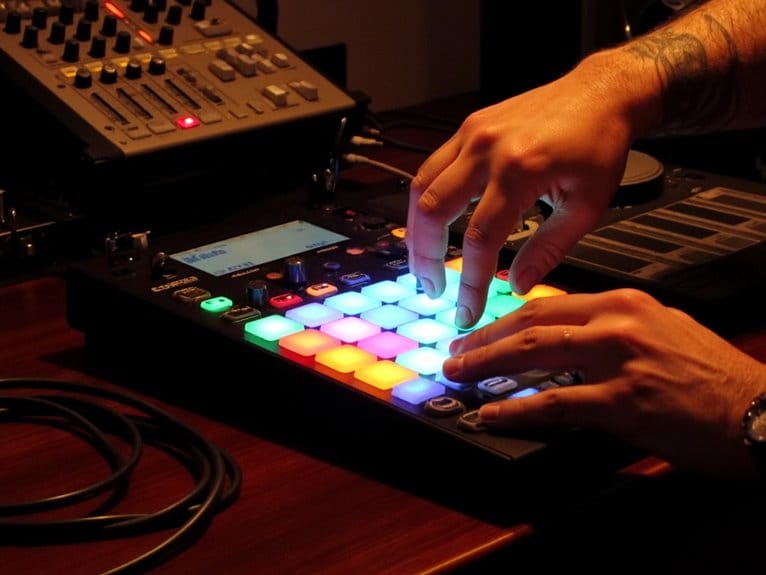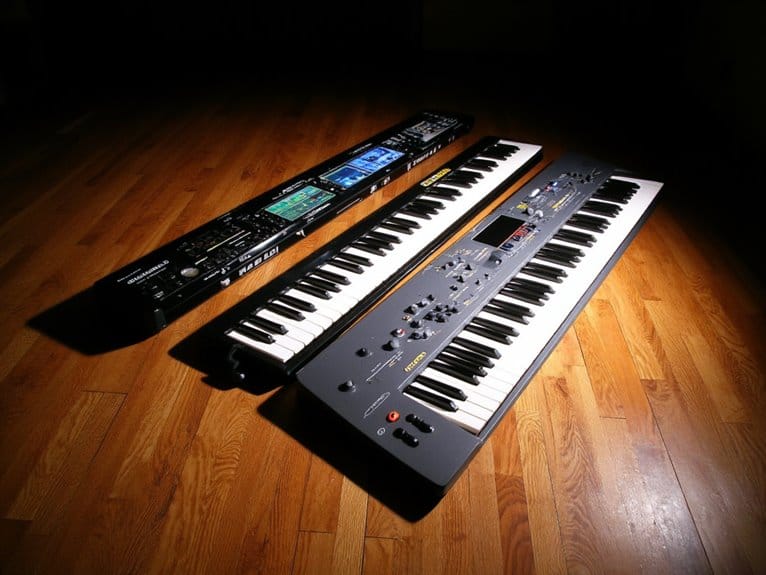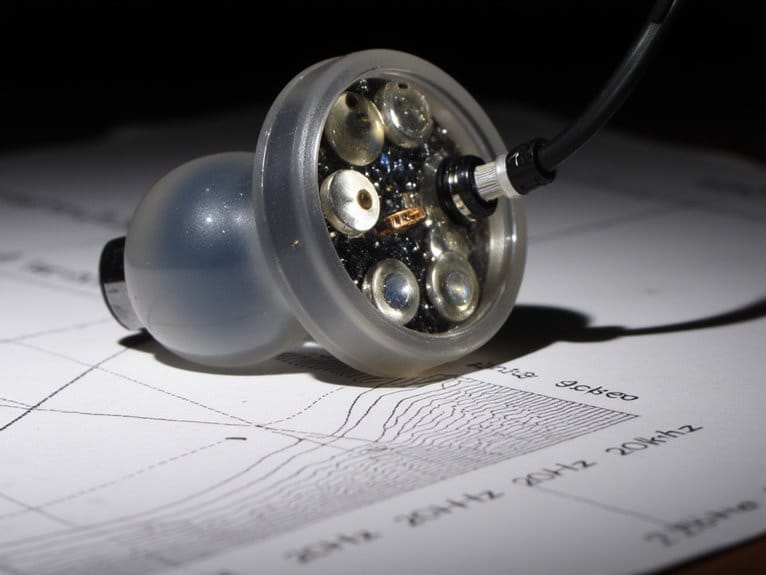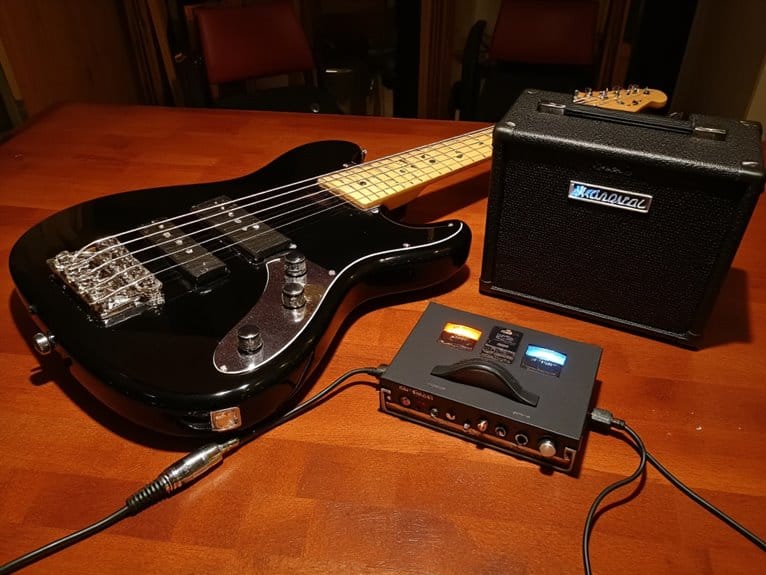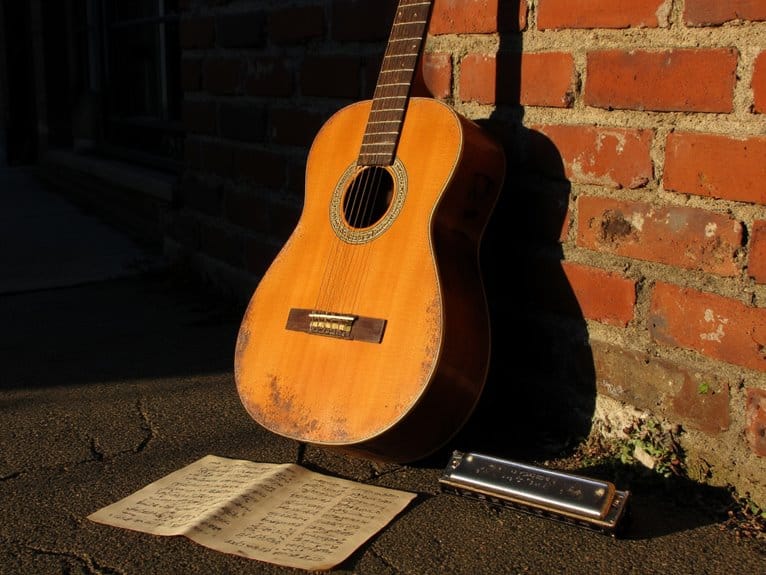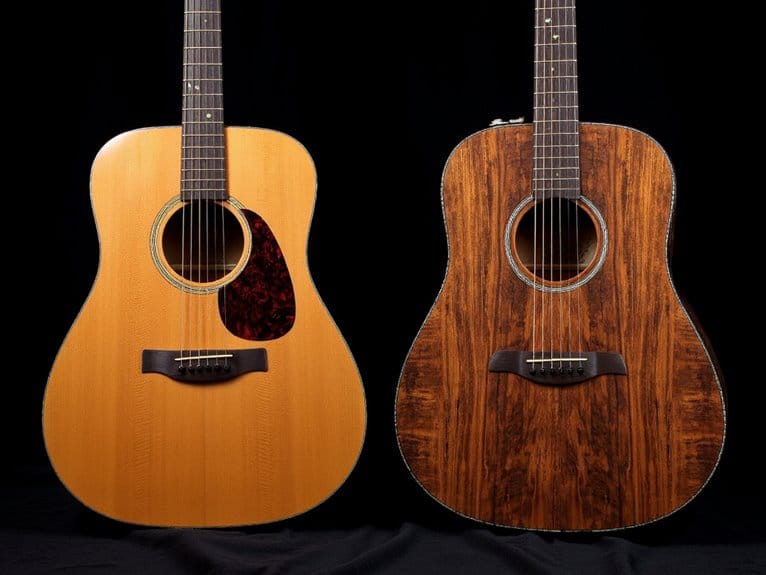How to Use Compression Effectively With Guitar
You’ll want to set your compressor’s threshold just above your average playing level, then dial in a 3:1 to 5:1 ratio for controlled dynamics without squashing your tone’s natural character. Use medium-slow attack times around 20-30 milliseconds to preserve pick articulation, while matching release times to your song’s tempo for sustained notes that decay naturally. Aim for modest 3dB gain reduction rather than heavy compression, which can drain life from your sound and turn punchy riffs into lifeless mush. These foundational techniques reveal professional-quality results across any musical context.
We are supported by our audience. When you purchase through links on our site, we may earn an affiliate commission, at no extra cost for you. Learn more.
Notable Insights
- Set threshold just above average signal level with a 3:1 to 5:1 ratio for optimal dynamic control without over-compression.
- Use medium-slow attack times (20-30ms) to preserve pick articulation and match release time to song tempo.
- Choose optical compressors for smooth clean tones, FET for aggressive electric sounds, or VCA for transparent versatility.
- Apply conservative 2:1 to 3:1 ratios for clean guitars and use bus compression to glue multiple distorted tracks together.
- Aim for 3dB gain reduction maximum and regularly compare compressed versus uncompressed signals to avoid lifeless tone.
Understanding the Fundamentals of Guitar Compression
Guitar compression might seem like one of those intimidating technical concepts that’ll have you scratching your head, but I’ve found it’s actually one of the most practical tools you can master as a player.
At its core, compression basics involve controlling your guitar’s dynamic range, which is simply the difference between your quietest and loudest notes.
Mastering dynamic range control is the foundation that separates amateur players from those who truly understand their instrument’s voice.
When you dig into the strings hard during an aggressive passage, compression automatically reduces those peaks, while simultaneously bringing up your softer passages to create a more balanced, consistent signal. Each instrument has a unique ADSR envelope, so practicing with different guitar sources helps you recognize how various playing styles and tones respond to compression.
This dynamic control protects your amp from unwanted distortion, adds sustain to your notes, and helps maintain that sweet spot where every note cuts through the mix with clarity and punch. Many modern multi-effects pedals include sophisticated compression algorithms alongside other essential effects like distortion, overdrive, delay, and reverb. Think of compression like salt in food – it enhances your guitar’s natural characteristics and can make your sound bolder, but too much will overwhelm your tone’s natural flavor.
Essential Compression Parameters and Their Impact on Tone
Once you’ve got a handle on what compression does for your guitar signal, the real magic happens when you start tweaking the individual parameters that control how it responds to your playing. I’ve found that mastering these five core settings transforms compression from a mysterious black box into a precision tool that enhances your tone rather than fighting against it.
| Parameter | Sweet Spot | Impact on Tone |
|---|---|---|
| Threshold | Just above average signal | Controls when compression engages |
| Ratio | 3:1 to 5:1 | Determines compression intensity |
| Attack Time | Medium-slow | Preserves pick articulation |
| Release Time | Match song tempo | Maintains natural sustain decay |
Your threshold settings determine when compression kicks in, while ratio adjustments control how aggressively it works. Attack time affects transient response, release time shapes sustain character, and makeup gain balances your output level. For optimal results, I recommend using a harder knee setting to enforce your threshold more strictly and ensure consistent compression behavior across different signal levels. Many budget interfaces now feature high-performing mic preamps that allow you to capture the nuanced dynamics of your compressed guitar signal with professional clarity. Whether you’re using a basswood body guitar or other materials, understanding these compression parameters helps you make the most of your instrument’s natural tonal characteristics.
Comparing Optical, FET, and VCA Compressor Types
The three main compressor circuit types—optical, FET, and VCA—each deliver distinctly different sonic characteristics that can dramatically shape your guitar’s dynamic response and tonal color.
Optical compressors use LED-controlled gain reduction for smooth, natural compression with slower attack times, making them perfect for clean tones and fingerstyle playing.
Optical compressors deliver gentle, musical compression with naturally slow attack times, making them ideal for pristine clean tones and expressive fingerstyle guitar work.
FET compressors provide aggressive, fast compression that adds punch and grit, ideal for electric guitars needing attitude and presence.
VCA compressors offer transparent, precise control with extensive parameters, delivering clinical accuracy without tonal coloration.
Despite compression myths suggesting one type fits all guitarists preferences, choosing the right circuit depends on your musical context—optical for vintage warmth, FET for character-driven aggression, or VCA for modern versatility and mix compatibility.
When recording acoustic-electric guitars, pairing compression with quality phosphor bronze strings can enhance the natural warmth and resonance that translates well through pickup systems.
Tailoring Compression Settings for Clean Guitar Tones
When I’m dialing in compression for clean guitar tones, I’ve learned that subtlety becomes your greatest asset, requiring a delicate balance between dynamic control and preserving the natural articulation that makes clean playing so expressive.
For effective clean tone optimization, I’ll set my threshold just above the average performance level, targeting peaks with a conservative 2:1 to 3:1 ratio that maintains transparency without squashing transients. My attack time stays around 20-30 milliseconds, allowing that essential pick attack to pass through unaffected, while faster release times prevent lifeless sustain.
Dynamic range management improves dramatically when I utilize parallel compression at 50% blend, combining controlled dynamics with natural feel. Modest 3dB gain reduction with proper makeup gain guarantees your clean guitar retains its expressive character.
For guitarists seeking additional tonal enhancement, overdrive distortion pedals can complement compression by adding controlled saturation while maintaining the dynamic characteristics that compression helps establish. Many players find that incorporating true bypass circuitry in their signal chain preserves the natural guitar signal integrity when effects are disengaged. Understanding proper DC 9V power requirements ensures your compression pedal maintains consistent performance throughout your playing sessions.
Managing Dynamics in Distorted and Overdriven Guitar Tracks
When you’re working with distorted and overdriven guitar tracks, you’ll discover that your amp or overdrive pedal already provides natural compression through saturation.
This means you need to approach additional compression more strategically than with clean tones. I’ve learned that bus compression becomes particularly valuable for gluing multiple heavy guitar tracks together, creating that cohesive wall of sound that makes professional metal and rock mixes sound so powerful and unified.
The biggest challenge you’ll face is avoiding over-compression, since excessive gain reduction can quickly flatten your guitar’s natural dynamics and rob it of the aggressive punch that makes distorted tones exciting in the first place.
Natural Amp Compression
Why does your guitar sound so much smoother and more controlled when you’re cranking a tube amp compared to playing at bedroom volumes?
Natural amp compression occurs when your tube amplifier’s power section reaches its headroom limits, automatically compressing your signal by raising the volume floor of quiet notes while creating a ceiling effect for the loudest peaks. This compression happens without external pedals, resulting from your amp’s inherent design limitations and speaker response.
When you adjust your amp settings for higher gain and volume, you’re fundamentally trading dynamic responsiveness for that coveted “glue” that makes your playing feel more cohesive and sustained. Many players enhance this natural compression further by incorporating distortion pedals that preserve low-end fundamentals while adding harmonic saturation. Just as metal vocalists need equipment capable of handling extreme SPL without distortion, guitar amplifiers must manage high-intensity signals while maintaining clarity and control.
- Your amp naturally squashes dynamics, smoothing differences between soft and aggressive picking
- Power tube saturation creates compression that enhances sustain without external processors
- Higher volumes engage natural limiting, producing the controlled feel professional players seek
Similar to how Alnico magnets provide warmer vintage character in pickup design, your amp’s natural compression creates that organic, musical response that players have sought for decades.
Bus Compression Techniques
While natural amp compression handles dynamics beautifully at high volumes, most recording situations demand a different approach since cranking tube amps to their saturation point isn’t always practical in modern studios or home setups.
Bus compression becomes your secret weapon for managing multiple distorted guitar layers, creating that unified wall of sound you’re after. By routing all your distorted tracks to a single bus, you’ll control wayward dynamics without crushing individual performances.
I typically use moderate ratios around 2:1 to 4:1, with attack times between 20-30 milliseconds to preserve those essential pick transients.
Different compressor types—whether VCA, optical, or tube-based—add their own sonic character, so experiment to find what complements your guitar tone best. Just as with microphone selection, factors like signal-to-noise ratio above 70 dB help maintain clean recordings when capturing your compressed guitar signals.
Consider pairing bus compression with overdrive pedals that provide dual-channel capabilities, allowing you to layer clean boost with saturated drive for enhanced dynamic control before the signal reaches your compressor. Maintaining true bypass functionality in your pedal chain ensures your compressed signal reaches recording equipment without unwanted tone coloration or signal degradation.
Avoiding Over-Compression Issues
Although distorted and overdriven guitar tracks already possess natural compression from amp saturation, I’ve witnessed countless mix engineers make the critical mistake of adding heavy-handed compression that transforms punchy, aggressive tones into lifeless mush.
The key to avoiding these compression pitfalls lies in recognizing when you’re stealing the dynamic range that gives distorted guitars their character and power.
- Keep gain reduction around 3 dB maximum, using moderate 2:1 to 3:1 ratios to control peaks without crushing dynamics
- Set attack times between 3-30 ms to preserve essential transients while allowing fast release times around 50 ms for quick recovery
- Monitor compressed versus uncompressed signals regularly, listening for dulled attacks, pumping artifacts, or excessive noise amplification
When monitoring your compressed guitar tracks, consider using a quality headphone amplifier to ensure you’re hearing the true impact of your compression settings on the guitar’s dynamics and tonal character.
Proven Settings and Techniques for Professional Results
Getting compression right on guitar isn’t about memorizing rigid formulas, but rather understanding how specific parameter combinations create the sonic character you’re after in different musical contexts. These advanced techniques dispel common compression myths while delivering professional results consistently.
For acoustic guitars, I’ve found that 4:1 ratios with medium attack times around 25-30 ms preserve essential string transients while maintaining control.
Electric guitars typically respond better to 3:1 ratios with faster 3-5 ms attacks, though you can push to 5:1 for aggressive styles.
Set your threshold just above average input levels, targeting roughly 3 dB of gain reduction.
Don’t forget to automate threshold values during dynamic performances, and always apply makeup gain to maintain consistent perceived loudness throughout your mix.
Common Mistakes and How to Achieve Natural-Sounding Compression
Despite mastering the technical parameters I covered earlier, many guitarists still struggle with compression that sounds artificial. I’ve noticed this usually stems from five critical mistakes that transform a musical tool into a dynamic destroyer.
The most damaging compression misconceptions involve applying extreme settings without musical intent, resulting in lifeless tones that squeeze the soul from your performance. Over-compression flattens natural attack characteristics, while incorrect attack times between 5-30ms can kill your pick’s initial transient response.
- Set modest ratios (2:1 to 6:1) with gentle gain reduction to preserve natural dynamics
- Use multiple gentle compressors in series rather than one heavy-handed processor
- Assess your specific goal before applying compression—leveling, sustain enhancement, or tonal enhancement
I’ve found that dialing back extreme settings to half their initial intensity often restores musicality while maintaining control. Just as analog circuits produce warmer, more authentic tones preferred by guitarists, proper compression settings should enhance rather than mask your instrument’s natural voice. Pedals with true bypass circuitry help maintain your original tone’s integrity when compression is disengaged, allowing for better A/B comparisons during the dialing-in process. Just as flat frequency response headphones reveal compression artifacts during monitoring, using reference-quality playback equipment helps identify when your compression settings are destroying rather than enhancing your guitar’s natural character.
Frequently Asked Questions
Should I Place Compression Before or After Distortion Pedals in My Signal Chain?
You should typically place compression before distortion pedals. Pre distortion compression preserves your playing dynamics and articulation before signal saturation occurs. Post distortion clarity suffers when you compress an already saturated signal.
How Does Compression Affect Guitar Tone When Combined With Reverb and Delay Effects?
Compression synergy with reverb and delay creates enhanced tonal clarity by controlling dynamics. You’ll achieve smoother effect tails when compressing first, or increased sustain and punch when placing compression after spatial effects.
Is It Better to Compress During Recording or Add Compression Later in Mixing?
You’ll find mixing techniques offer more flexibility for compression adjustments within the full arrangement context. However, recording workflow with early compression can capture polished tones directly, though it limits later creative options.
Can Parallel Compression Work Effectively With Guitar Tracks Like It Does With Drums?
Yes, you can use parallel processing effectively on guitars, though it requires different settings than drums. You’ll need careful tonal balance adjustments since guitars have longer sustain and less percussive transients than drum hits.
On a final note
You’ve now got the essential tools to transform your guitar tracks through strategic compression application. Whether you’re taming aggressive pick attacks on clean passages, controlling sustain in overdriven sections, or adding that professional polish to your recordings, remember that subtlety typically wins over heavy-handed processing. Trust your ears, experiment with different compressor types, and don’t be afraid to bypass the effect entirely when the natural dynamics serve your musical vision better.


